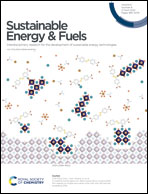The effects of oxygen pressure on the discharge performance of potassium–oxygen batteries†
Abstract
The potassium–oxygen battery (KOB) has distinguished itself from other metal–oxygen batteries by its facile cell chemistry that enables thousands of cycles with negligible performance loss. Recently, the main discharge product KO2 was reported to undergo a reduction towards K2O2 in the absence of oxygen, which was identified as the cause of diminished rechargeability. This raises the question how oxygen partial pressure p(O2) affects the discharge behavior of KOB. In this study, the influence of p(O2) on the discharge performance is assessed between 0.2 atm and 11 atm. The p(O2)-dependent cell failure mechanisms are investigated by post mortem analysis of the discharge product formed on a carbon cathode. Low p(O2) results in insufficient oxygen transport throughout the cathode leading to low rate capability and capacity. In addition, we find that oxygen depletion promotes parasitic reactions involving the electrolyte solvent dimethyl sulfoxide. High p(O2) is identified as an effective approach towards preventing oxygen depletion and subsequent side reactions. Furthermore, high p(O2) also drastically improves the discharge performance by enabling more efficient cathode utilization. These findings suggest that a high-pressure supply of pure oxygen will be advantageous to further increase cell performance of KOB and thus open avenues for yet unexplored applications.



 Please wait while we load your content...
Please wait while we load your content...